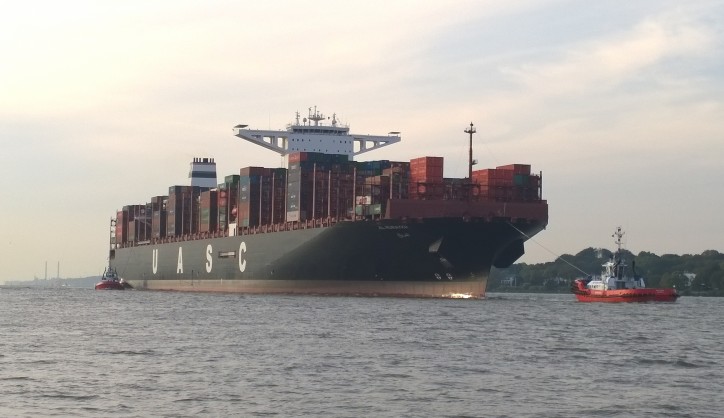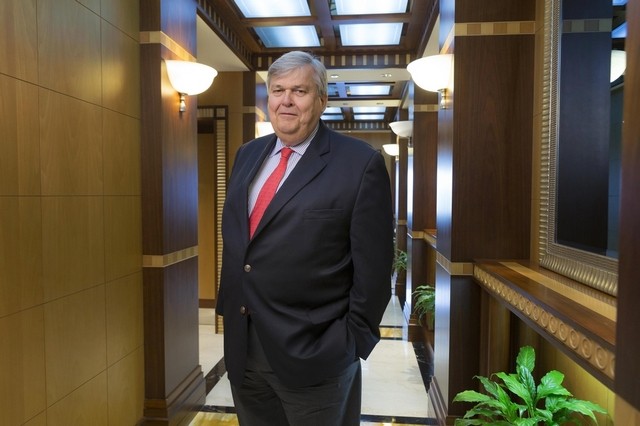United Arab Shipping Co (UASC), which is merging with the German container shipper Hapag-Lloyd, expects most of the tie-up’s US$400 million cost savings to come from operations rather than lay-offs, its chief executive says.
UASC and Hapag-Lloyd are merging by the end of this year to become the world’s fifth-largest container carrier as a wave of consolidation in the container shipping industry accelerates.
"Our initial hypothesis is there will be fewer lay-offs than many people would normally expect in a merger," Jorn Hinge said.
"The largest portion of this amount [$400m] comes from deploying the optimal size ship for each of the trades where the combined company will operate."
For example, cost savings will come from negotiating better procurement terms, he adds.

Container shippers are merging as they grapple with low freight rates, anaemic trade volumes, and vessel overcapacity, which have dented their earnings.
Hapag-Lloyd’s merger with UASC is its second consolidation in two years, after acquiring the Latin American rival CSVA’s container business in 2014.
Despite the latest merger announcement, Hapag-Lloyd issued last month a profit warning for its 2016 financial year, citing the one-off costs of the merger, higher bunker prices and low freight rates.
For its part, UASC says revenue for this year will very much depend on the trajectory of freight rates. UASC’s revenue rose 2 per cent last year to $3.3 billion from $3.24bn a year earlier.
"The outlook for 2016 is for UASC to continue growing ahead of the market due to increased volumes with our new vessels that have been delivered throughout the first half of this year," says Mr Hinge. "The exact amount of the revenue growth will depend on how freight rates evolve during the remainder of this year. "
The significant number of ultra-large container ships (ULCS) coming to the saturated market combined with weak demand has left freight rates tumbling, despite low bunker prices. With more ULCS expected to come to the market and continued lacklustre trade growth, rates are not expected to pick up this year.
Growth in the volume of global trade is forecast by the World Trade Organisation to remain low this year at 2.8 per cent, unchanged from the 2.8 per cent increase recorded last year.
This year is projected to be the fifth year in a row of trade growth below 3 per cent.

Mr. Jorn Hinge, UASC President and Chief Executive Officer
Companies are competing intensely, going for market share and hanging on to high utilisation rates rather than idling capacity.
But the tide needs to turn in order for the container shipping industry to survive, according to Mr Hinge.
"One alternative would be for container lines to adjust to the new market conditions and, as with other asset-intensive industries, accept that the utilisation rates do not remain at or above 95 per cent in the short- to mid-term," he says.
"However, for container lines to accept lower utilisation rates would require a significant shift in mindset and probably also adjustments to their internal tools and processes."
The tie-up with Hapag-Lloyd is UASC’s solution to the current market conditions, which Mr Hinge does not expect to improve anytime soon.
"Scale economies are a key driver for the financial results in this industry and, with the excess capacity that is projected in the industry for the foreseeable future, it does not make sense to continue growing organically to build that scale," says Mr Hinge.
The merger also will change the shareholder base of UASC, which was set up in 1976 in Kuwait.
Qatar and Saudi Arabia will have 14 per cent and 10 per cent stakes, respectively, in the combined entity. The remaining shareholders, including the UAE, Kuwait, Iraq and Bahrain will each hold less than 2 per cent.
UASC’s marriage to Hapag-Lloyd is a good match, according to Philip Damas, a director of supply chain advisors at the consultancy Drewry.
"UASC was clever in modernising its fleet of vessels in the last few years so it has something attractive to Hapag- Lloyd, which is very large container ships of 18,000 TEU (twenty-foot equivalent units) or more," he says. "Hapag-Lloyd, frankly, desperately needed these large container ships because [it] was slow in modernising its fleet of container ships."
UASC spent $2.3 billion to build 17 new vessels, six of them with a capacity of 18,800 TEUs and 11 with capacity of 15,000 TEUs, boosting its fleet to 60, with two more on the way next year. The combined entity, which will be based in Hamburg, will have a fleet of 237 vessels, with total transport capacity of about 1.6 million TEUs.
Both companies are strong on the Asia-West route and UASC’s particular forte in the Middle East was an added catalyst, Mr Damas adds.
Source: The National